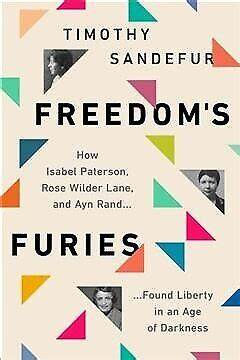Founding Mothers of Liberty
- Tamara Shrugged
- May 9, 2024
- 3 min read
Updated: May 3
“Their critique of the New Deal laid the intellectual groundwork for a revival of interest in economic and personal liberty that is today typically called libertarianism.” – Freedom’s Furies
The start of the twentieth century brought about the first totalitarian experiment in history with Woodrow Wilson’s entry of the US into World War I, when Wilson raised up a new generation to fight involuntarily in the new war. This watershed moment began an ultranationalistic collectivist movement that would continue throughout the century as personal autonomy and responsibility were ceded to the idea of a national community.
But the early twentieth century also saw a new age of technology with the arrival of airplanes, cars, radios, and telephones, conveniences previously absent from primitive life. As a result, rural America saw an exodus from the drabness of an agrarian existence to the possibilities growing in the city centers.
In Timothy Sandefur’s 2022 book, “Freedom’s Furies”, Sandefur tells the story of three independent women who formed a friendship and then a bond amid the Great Depression, as they found their common enemy in the policies of Herbert Hoover, and then Franklin D. Roosevelt (FDR), whose New Deal schemes were deemed the antithesis of America’s founding principles. Each published their own treatise on the subject in 1943, advancing the development of libertarian thought. The Founding of our Fathers would not be enough to maintain the light of liberty, it would take three remarkable women to reorient America, back onto the right path.
In the 1920s, a literary movement began with the shunning of small-town traditional values in lieu of new opportunities in the big city. This intellectual resistance became known as “The Revolt from the Village. Gone were the Puritan values of neighborliness and community-based life of thrift and wholesomeness. But it wouldn’t last long when the libertine 20s led to the Depression in the 30s.
Hoover's poor economic policies prevented the economy from recovering, while FDR doubled down to make matters worse. The New Deal not only allowed broad executive powers to battle the Great Depression with the government serving as caretakers but also created permanent changes in the makeup of Americans by ushering in an era of government planning.
Following the new tyranny emanating from New Deal policies, another literary movement called “Resilience-based novels”, grew in popularity beginning in the 1930s, as authors put bourgeois values back in style, by increasingly writing about characters with personal strengths and self-reliance. Rose Wilder Lane along with her mother, Laura Ingalls Wilder, created the Little House on the Prairie series denoting the sentiment of those times.
Not always in lockstep in their philosophies or writing styles, Isabel Paterson, Rose Wilder Lane, and Ayn Rand collaborated to rekindle the zeal for American exceptionalism, having lost its luster following years of totalitarian-like dependence. With the world, itself, succumbing to collectivist schemes in Italy, Germany, Russia, and the US, a dark new age was appearing. With freedom in retreat following experiencing unprecedented liberty and freedom in the early 20th century, and recognizing how quickly government rushes in when personal autonomy and community support are lost, three books, in 1943, would attempt to turn the tide.
Isabel Paterson, a literary gossip columnist, in her non-fiction book, “The God of the Machine”, revealed her philosophy of individual sovereignty, defending the need for freedom to allow the creative energies of entrepreneurs to thrive. The government’s conceit to control such energies through collectivism failed spectacularly and led to the resurgence of individualism. Rose Wilder Lane, in her book, “The Discovery of Freedom”, focused on the history of liberty and humanity’s attempts to perfect it. Lane believed that liberty was a natural occurrence that humans discovered and not one that was simply assembled over time. Ayn Rand, a best-selling novelist, in her fictional book, “The Fountainhead”, wrote of one man against the system. Also advocating self-reliance, Rand defended the men of the mind from the hatred of the good for being good. In her defense of success and achievement, she championed society’s builders, advancing individualism over collectivism and independence over conformity.
Like the Founding Fathers that came before them, Paterson, Lane, and Rand reinvigorated the message of freedom through their literary works and became known for launching what would become the libertarian movement of individualism and political freedom.







Comments